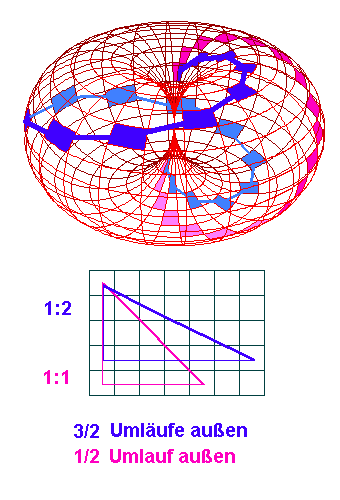(this is an investigation, no conclusions yet)
The magnetic moment of the proton, $\mu_p$, is
$$\mu_p=2.79284735\mu_N$$
$\mu_N={e\hbar\over2m_p}$
$\mu_p={2.79284735e\hbar\over2m_p}$ (*1)
$e=$ elementary charge
$\hbar = {h\over2\pi} =$ reduced Planck's Constant, $h=$ Planck's constant
$m_p=$ proton mass
We can compare this to calculating the magnetic moment of various charge distributions of the proton and step through various configurations and stable patterns until the correct answer is found.
(this may have already been done before, however, I am going to do it again, step by step, to uncover if anything was missed that led to the formation of the quark model)
The proton is a vortex in the aether, thus, the flowing aether is the flowing charge. The interesting thing will be the correct math for the charge vortex - a stable vortex in the yet to be defined superfluid aether.
Let's examine some simple cases first: (with excess derivation steps for easy checking)
$\textbf{Case One: Ring of Current at Proton's Equator}$
Assume total charge of proton is at a point a distance $r_p$ from center, just like we did when deriving the proton radius from quantized angular momentum. This is likely going to result in an answer that is EXCESSIVE magnetic moment, because the charge is actually distributed, not in a single point like this, however, we proceed:
(note: it can be shown that a linearly distributed charge "e" around the radius of the proton would results in the same magnitude circular loop current - TBD)
Circular loop of current of radius $r_p$ (proton radius):
$$\bar{M}=I\bar{A}$$
$\bar{M}=$ magnetic moment
$I=$ loop current, defined as elementary "e" moving at "c" at radius "$r_p$"
$I={e\over\triangle t}$
$\triangle t = {2\pi r_p \over c}$
$I={e\over{2\pi r_p\over c}}$
$I={ec\over2\pi r_p}$
$\bar{A}=$ area
$\bar{A}=\pi r_p^2$
$$\bar{M}={ec\over2\pi r_p}\pi r_p^2$$
$$\bar{M}={ecr_p\over2}$$
$$r_p={2h\over\pi cm_p}$$
$$\bar{M} = {{ec{2h\over\pi cm_p}\over2}}$$
$$\bar{M} = {he\over\pi m_p}$$
$$\bar{M}= {2\pi\hbar e\over\pi m_p}$$
$$\bar{M}= {2e\hbar\over m_p}$$
re-writing to be in form of (*1):
$$\bar{M}= {4e\hbar\over2m_p}$$
$\mu_N={e\hbar\over2m_p}$
$$\bar{M}= 4\mu_N$$
We have a factor of 4 instead of 2.79284735, so this is too much magnetic moment.
$\textbf{Case 2: Rotating Uniformly Charged Solid Sphere of the Proton's Radius}$
Rotating uniformly charged solid sphere of Radius R, total charge Q, angular velocity $\omega$:
$$\bar{M}={1\over5}Q\omega R^2$$
Using our proton radius solution, and assuming the speed of light, c, for the ve;ocity of our rotating proton at the point $r_p$ from the center of the proton:
$$\omega = {2\pi\over\triangle t}$$
$$\triangle t = {2\pi r_p\over c}$$
$$\omega={c\over r_p}$$
$$\bar{M}={1\over5}Q{c\over r_p}R^2$$
$$\bar{M}={1\over5}e{c\over r_p}r_p^2$$
$$\bar{M}={1\over5}ecr_p$$
$$r_p={2h\over\pi cm_p}$$
$$\bar{M}={1\over5}ec{2h\over\pi cm_p}$$
$$h=2\pi\hbar$$
$$\bar{M}={1\over5}e{4\hbar\over m_p}$$
$$\bar{M}={8\over5}{e\hbar\over2m_p}$$
$$\bar{M}=1.6{e\hbar\over2m_p}$$
$\mu_N={e\hbar\over2m_p}$
So, here in one evening, we have bracketed above and below the solution:
A too high estimate, 4.0, and a too low, 1.6, as compared to the measured coefficient of 2.79284735 for the magnetic moment of the proton.
These charge distributions that we have examined are not realistic charge distributions (stable vortex superfluid aether flow paths), so over the next series of posts, we will evaluate other more realistic charge flows/distributions and develop a Shape Factor (SF) to compare various possible stable patterns and solutions.
If simple solutions do not fall out, we will move on to fluid dynamics and solutions of nonlinear systems
Navier-Stokes equations.






